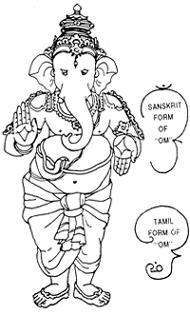GANESHA
AND 'OM' |
|
The great siddha saints have described the flow of Ida Nadi (flow out of breath) as extending up to twelve digits from the lower end of the nose and the way of attaining samadhi is to control and regulate this flow. Verily the trunk of Ganesha represents this invisible flow of breath which is responsible for the phenomenal world. The Vaishnava Hindus of South India who worship God as Vishnu and his several incarnations gave prominence to Twelve Alwars who had become Godmen and notwithstanding Ganesha's Saiva affiliation, he was also personified and called Thumbikai Alwar (The Alwar with a trunk) and worshipped and given prominence as Deity to be propitiated for the removal of all obstacles in life. |
 It
may be noted that both in the Tamil form and in the Sanskrit form of writing
'OM' a similarity in features like the forehead, single tusk and trunk
with bent towards right as seen in Ganesha images is prominent. This similarity
appears to have been brought about to identify them with the mystic syllable
'OM'. The writing 'OM' itself is a compendious mark of a profound thought
and the image of Ganesha is an elaborate symbol of this profound thought
attracting universal attention in its silent eloquence.
It
may be noted that both in the Tamil form and in the Sanskrit form of writing
'OM' a similarity in features like the forehead, single tusk and trunk
with bent towards right as seen in Ganesha images is prominent. This similarity
appears to have been brought about to identify them with the mystic syllable
'OM'. The writing 'OM' itself is a compendious mark of a profound thought
and the image of Ganesha is an elaborate symbol of this profound thought
attracting universal attention in its silent eloquence.